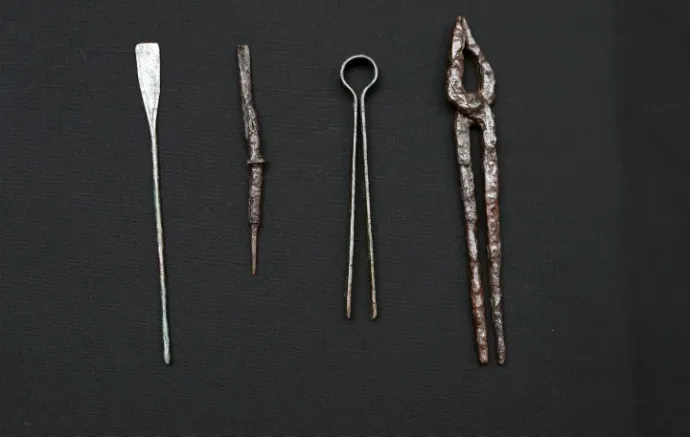Tomb of Roman physician buried with his medical equipment found in Hungary
The archaeologists of Eötvös Loránd University (ELTE), Jász Museum and the Eötvös Loránd Research Network have unearthed a find unique on a European scale: the tomb of a Roman physician from the 1st century AD, along with his complete equipment, in the Jász region of Hungary, MTI reports.
In the first phase of the excavation near Jászberény in 2022, the objects discovered were from the Copper Age and the Avar period, and then the site was surveyed using a magnetometer, Tivadar Vida, director of the Institute of Archaeology at ELTE said at a press conference in Budapest on Tuesday. Levente Samu, assistant research fellow at the institute, said that an earlier structure had also been found among the rows of tombs in the Avar cemetery, with several metal objects having been recovered from this relatively shallow grave.
The examination of the tools quickly revealed that this was a Roman burial complex, and the grave was that of a physician, whose equipment had been placed in two wooden boxes next to his feet. The tomb contained the remains of a man aged between 50 and 60 years, with no signs of trauma or disease. The grave was almost completely undisturbed, except for an animal disturbance which had moved one of the scalpels from the foot to the head. The tomb yielded pincers, needles, tweezers and high-end scalpels suitable for surgical operations, as well as remains of medicinal products.

The copper alloy scalpels were decorated with silver plating and fitted with interchangeable steel blades. A muller was placed at the knee of the deceased, which, judging by the abrasion marks, could have been used to mix herbs and other medicines. According to Levente Samu, these instruments represent the highest quality of the age and were suitable for use in complex medical procedures.
László Borhy, archaeologist and rector of ELTE, pointed out that such a complete medical kit is unrivalled both inside and outside the borders of what was the Roman Empire. According to radiocarbon dating, the tomb dates back to the 1st century AD, the period of the formation of the province of Pannonia. Ongoing genetic testing will hopefully shed light on the Roman doctor's origins.
Benedek Varga, Director of Semmelweis Museum of Medical History
called the discovery of such an assemblage from the Barbaricum of the 1st century BC a world sensation. Only one similar medical kit from the period has ever been discovered: in Pompeii, which was one of the richest settlements in the empire.

Levente Samu said that in addition to genetic research, they also plan to carry out an isotopic analysis of the skeleton, which will help determine whether the doctor was of local origin.
András Gulyás, archaeologist and museologist at Jász Museum, pointed out that this period in Jászság may have been a transitional period between the Celtic and Roman Sarmatian populations. It is not clear from the current data whether the physician buried in the tomb was there to heal a local leader of high prestige or whether he was accompanying a military movement of the Roman legions.
For more quick, accurate and impartial news from and about Hungary, subscribe to the Telex English newsletter!